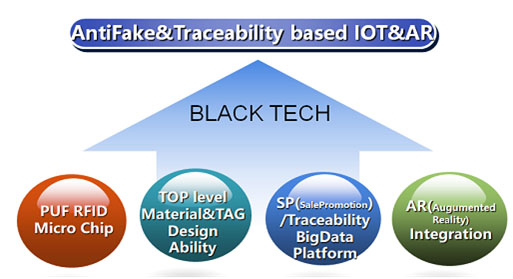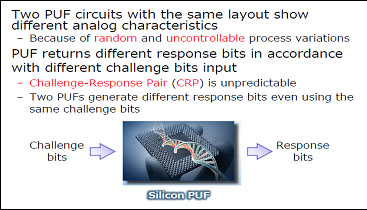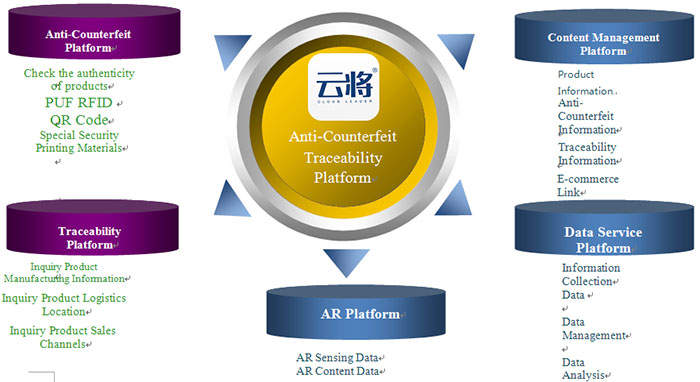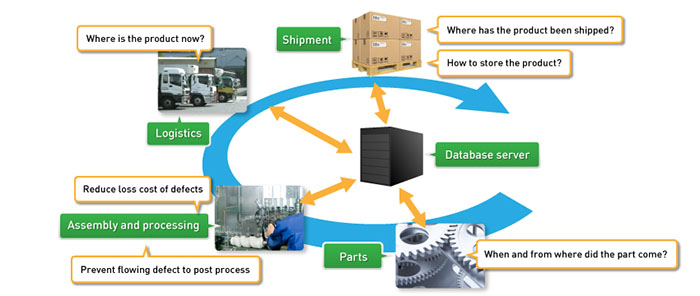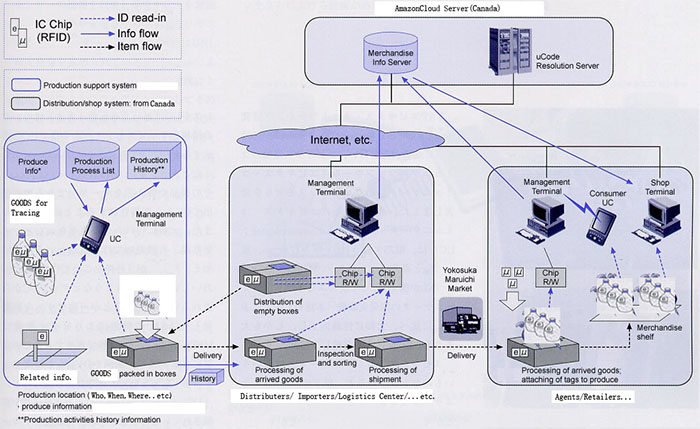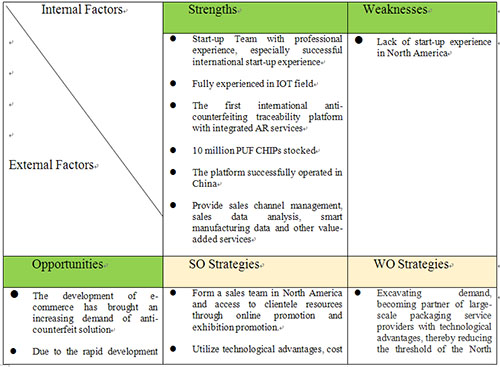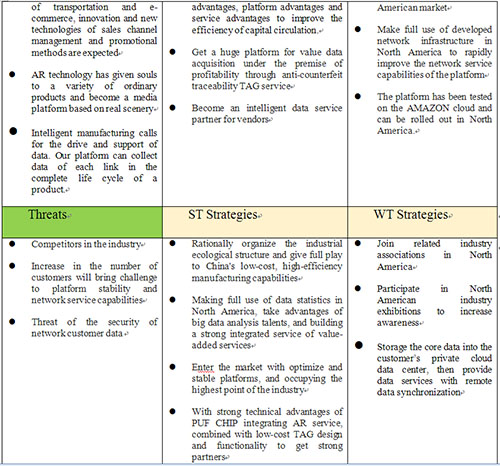Anti-Fake and Traceability Based IOT +AR
◆ Industry Background
Imitation is supposed to be the sincerest form of flattery, but that is not how most companies see it. The Organization for Economic Co-Operation and Development (OECD) estimates that the international trade in counterfeit and pirated goods was worth around $500 billion USD in 2016 or around 2.5% of global imports with U.S. Italian and French brands being hit the hardest - with much of the proceeds going to organized crime factions. Counterfeiting “used to be a luxury goods problem”, says Therese Randazzo, who is in charge of protecting intellectual property at America's Customs and Border Agency. Today, fake products crop up in everything from handbags to perfumes, machine parts, chemicals, pharmaceuticals and even weapons used by militaries around the world. The graph below shows the countries hardest hit by trade in fake goods and, on the right, the top countries where fake goods originate from.
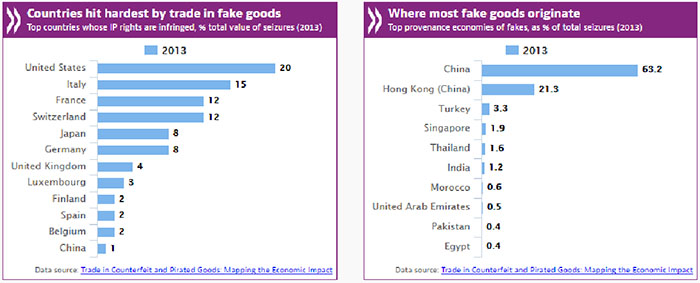
The technology used to counter pirates is also becoming more sophisticated. Holograms (as seen on money, for example) are a cheap way to distinguish real items from fakes, although counterfeiters are getting better at copying them. Special inks, watermarking, and other “covert” technologies (meaning those invisible to the naked eye) are becoming more popular as a result. Many “brand protection” firms have also started to peddle radio-frequency identification (RFID) technology to help companies track shipments. This allows firms to tag boxes and crates with chips which send out signals identifying them as authentic. However RFID technology is readily available and easily replicated. The most foolproof technique for identifying genuine goods involves companies like - capable of producing and incorporating materials with special genetic markers into the packaging or product itself. Firms, officials and end-users can then literally check an item's DNA to ensure that it is real. However the broadening scope and magnitude of counterfeiting is a significant concern and a key economic threat that undermines innovation and hampers economic growth.
The Physical Unclonable Function (PUF) RFID and mobile Internet anti-counterfeiting technology platform based on the Internet of Things (IOT) awareness can conveniently collect the position and time information of anti-counterfeiting goods, starting from the production of such goods and across each and every aspects of logistics transportation, transit, and terminal retail. The platform can also store those data in the platform database for classifying and future reference for suppliers, brokers, third-party regulatory agencies and retailers and provide data analysis to clients on a need basis. End-users can also easily access rights-protected information such as origin, supplier, and legal sales area of purchased products - through smart phones. In this way, the full process data of goods production - delivery - transportation - transit - agents - retailers - users can be traced.
◆ Technical Solutions
We developed an anti-counterfeit traceability platform named Cloud Leader. The platform uses RFID Chips with Physical Unclonable Functions as the only TAG ID. The TAG ID will be designed as a non-recyclable, one-time-use globally unique identity tailored to fit the characteristics of the anti-counterfeit object. The matching anti-counterfeiting QR code customized with the top anti-counterfeiting materials jointly acquired with the Japanese TOPPAN Group from Verayo, combined with the smart phone APP and the back-end cloud service data management platform, can achieve the requirements of anti-counterfeit traceability. At the same time, the server is equipped with Augmented Reality (AR) content server and AR engine software to provide digital media promotion services to end users. It uses Augmented Reality technology to provide manufacturers with a brand culture promotion platform, secondary purchase channels, and facilitate promotional methods. Using our solutions, the brand manufacturers not only ensure that products cannot be forged to maintain the brand image, but also obtain more value-added services.
1) Implement sales channel management
2) E-commerce platform for end-users
3) Provide promotion methods
4) Demonstrate brand value and cultural with AR technology
The Platform includes four core technologies, as below
PUF MicroChip: PUF is an object’s fingerprint using physical random pattern such as asperity of paper and fluctuation of magnetic pattern. Silicon PUF uses random process variation of each LSI device to generate digital data stream. Even if circuit pattern and digital data in LSI are copied, the device unique function cannot be cloned.
TAG Design Ability:According to the product's characteristics and usage, design TAG for the attachment of PUF Microchip and related antenna circuit to ensure the safety and practicality of the product's circulation.
Big Data Platform: The big data platform includes various data information related to product traceability, as well as product circulation, sales data, time, and consumption information. The data will be interactively linked to further integrate the manufacturer's procurement, production, inventory, sales and other relevant data and become a data-driven engine of manufacturing intellectual wealth.
AR Integration:This system innovatively embeds AR technology into the product's anti-counterfeiting traceability system, enabling users to further understand AR's technology in anti-counterfeiting identification and data tracing process, and to understand the product's own cultural background, production process, promotion, e-commerce, and other value-added services. It successfully transforms all ordinary consumer goods into a carrier for a new media promotion platform.
The anti-counterfeit traceability platform topology is as follows:
The traceability of product through the anti-counterfeiting traceability platform is as follows:
Platform data processing flow is as follows:
◆ Business Concept
As per my last point in the industry background, the most foolproof method of offering brand protection is a technique of incorporating a micro data chip with a unique, physically unclonable characteristic; meaning that each data chip is molecularly different from the next - thereby making it impossible to replicate. In my line of business, we refer to this as a Physical Unclonable Function (PUF). These are chips that are easy to make but practically impossible to copy once they are programmed. They are used in applications where cryptography and security is paramount.

My business is one that I have already been developing for quite some time and have a major contract with the largest Chinese Spirits Company in China - suppling them with this product for millions of their Mao Tai brands (3 million chips to date). It consists of directly inserting these unique microchips through a TAG into products. By embedding into certain accessories, they can be scanned, tracked to a digital cloud server and verified of their authenticity on a wholesale or retail level. Our company, for which I am the Chairman of the Board, is an integrated research and design organization that develops microchips specifically for the use of preventing the proliferation of counterfeit products from being sold from China. It's no secret that China has long been behind the global supply of counterfeit products. The counterfeiting problem in China is complex. Rational demand for brand names by low-income consumers and massive profits from producing counterfeit goods are incentives behind this massive global market. My company has made strides in fighting the counterfeit industry through the technology solutions that I have developed.
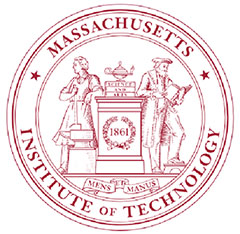
The Massachusetts Institute of Technology (MIT) is a private research university in Cambridge, Massachusetts, often cited as one of the world's most prestigious universities. MIT has given one company based out of California, Verayo, exclusive rights to 14 patents related to the development of the PUF technology .Working closely with our long-term partner TOPPAN, we have managed to acquire 15 millions of PUR RFID MicrioChip from Verayo through TOPPAN and obtained certain exclusive right from Verayo on the Mou Tai project in Chinese market. So far, out of 15 million MicroChips acquired, we have embedded three million to date in bottles of Mao Tai.
After having developed this technology in China, my goal would be to advance my growth by moving to Winnipeg where I can further deepen my relationships with Canadian, American and European businesses; some of whom are most deeply affected by counterfeiting and stand to benefit from my technological applications. Even though to date, I have already been in contact with several large Canadian agricultural exporters - wanting my technology applied to their products. It's one thing for exporter's products to say 'Made in Canada', but it's another thing to have undeniable proof that the products someone consumes indeed come from their stated origin.
Each chip costs about $0.06 CAD - so I am able to order them by the millions. Currently we still have approximately 10 million PUF RFID MicrioChips in stock. The equipment necessary to program and embed the chips into TAGs, however, is a bit more expensive - ranging in and around $300,000 CAD for the hardware, software and data chip programming functionality. There are currently no companies in the United States or Canada doing this business. I have several patents/IP pending in China and long-term good relationship with TOPPAN to ensure our access to the chips and technology for the foreseeable future. This is a tremendous opportunity to serve an incredibly underserved industry: fighting the sale of pirated goods around the world.
To start with, we will process all the Chips in China, but once volumes are enough – we will purchase the necessary equipment for Winnipeg, and process the chips there as well.
◆ IV. Key Management(Start-up Team)
With both a Bachelor of Science and a Master of Automatic Control, I have been working in my field for more than 20 years. A career that's included working as a Project Manager for the likes of Epson, one of the world's largest manufacturers of information and imaging related equipment; Kyocera, a Japanese multinational electronics and ceramics manufacturer as well as my current place of employment, Edify Technology Corporation and MegaByte Technology Corporation, where I am currently the Chairman of the Board, President and CEO. These two companies - for which I oversee - serve the burgeoning I.T. market in China and around the world. What started out as myself and four engineers has grown to a staff of over 20 full-time engineers and six sales staff. We create software tailored to meet the needs of our customers - whether it be related to workplace functionality, data backup, data storage or security, we are able to offer competitive software solutions for clients in a variety of industries. As for my own role, I am continually tracking industry trends, exploring new markets and entrenching ourselves in the business community. I am also a part-time professor at the Shangdong University of Science and Technology.
Other than myself, there are four partners in my start-up team specialized in engineering technology, finance, marketing, and sales.
Mr. Peng, Hui is the chief technology officer of our team. Mr. Peng graduated from Beijing University of Technology with Bachelor of Automation. When I established Beijing EdifyTimes Technology Co.,Ltd in 2003, Mr. Peng joined my founding team as a hardware engineer. He has been the head of technical research and development department and product application department of Beijing EdifyTimes over the past ten years. He has led his team to design and develop research and development over 10 kinds of products, including office automation equipment, educational equipment, intelligent campus platform, industrial automation control equipment, which are involving computer programming, Integrated circuit design, things technology and other technical fields. After more than 15 years working relationship, he is the perfect person in charge of Technology and R&D department for my new start-up team to start our business in Canada.
Ms. Suo, Miao is the financial director in our team. Ms. Suo has a Bachelor of Law from Beijing University of Aeronautics and Astronautics and a Master of Science from Lubin School of Business of Pace University in New York. She obtained the qualification of Certified Public Accountant in the State of New York. After completion of Master’s Degree, Ms. Suo went back to China and worked in financial field for more than 10 years. She was an audit manager at Ernst & Young Hua Ming in Beijing from 2005 to 2014. Currently, she is the financial director at Beijing YiTian ShiDai Trading Ltd. With her work experience and knowledge of financial system of China and North America, Ms, Suo is able to manage the financial affairs of our new start-up.
Ms. Zhang, Fang is the marketing director in our team. Ms. Zhang holds a Bachelor of Science from Hebei Normal University and a Master of English Education from Beijing Normal University. She has been working as a marketing professional at Beijing Extratech Analytical Ltd since 2008. The company is the exclusive sales and service agent for scientific instrument in China, Hong Kong and Macao. The company represents mainly electronic or scientific instrument companies from Europe, US and Japan, including Hiden Analytical Ltd in UK, Hiden Isochema Ltd in UK, Ionicon Analytik GmbH in Austria, Lycee Tec in Switzerland, etc. Ms. Zhang is well experienced to work with international companies for marketing and promotion of new products. She will lead our marketing team with marketing professionals in Canada to promote our product and services in North America.
Mr. Mei, Yupeng is the sales director in our team. Mr. Mei holds a Bachelor Degree in Machanical Design and Manufacturing from Dalian University of Technology. With professional knowledge in Manufacturing, Mr. Mei became a sales engineer after graduation. He started his career with Hinsong Spray Machinery & Eletric Equipment (Beijing) Co., Ltd when the company first established from October 1997 to February 2000. From March 2000 to February 2005, Mr. Mei worked as a senior sales engineer at Altas Copco (Shanghai) Trading Co., Ltd of Atlas Copco Group. In 2004, Mr. Mei achieved sales performance of 10 million CNY for the company. From March 2005 to present, Mr. Mei becomes a sales manager of Gardner Denver Machinery (Shanghai) Co., Ltd. In 2005, Mr. Mei’s team achieved sales performance of one million USD. In 2010, his team broke the sales performance of 50 million CNY. In 2015, his team achieved sales performance of approximately 100 million CNY. Mr. Mei will be the key of our new sales team in Canada to expand our sales in North America market.
◆ Market for the Product
Measuring the magnitude of global counterfeiting is not an easy task, however there is undeniable evidence that the economic damage sustained from counterfeit goods is significant. This damage affects consumers, trademark owners, companies, and sectors associated with the brand, including wholesalers and retailers, as well as the economy at large. Naturally, consumers experience lower-quality and less-effective products. This in turn undermines a brand’s integrity and can result in significant revenue losses. Specifically, IP owners sustain not only direct losses due to decreased market share, but also irreparable damage to the brand’s reputation and dilution of the brand, as along with costs related to defending their intellectual property rights.
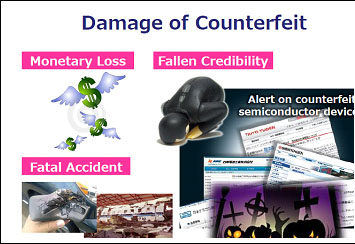
Indeed, direct losses of revenue due to counterfeit products are estimated at billions of dollars for each market segment and industry, and some companies spend as much as $20 million dollars each year in attempts to fight counterfeiting of their products. Counterfeit products also have detrimental effects on economies. In recent testimony before the Subcommittee on Oversight and Investigations, the U.S. Government Accountability Office reported that counterfeiting had slowed the growth of the U.S. economy and had resulted in decreased innovation, loss of revenue and taxation, and higher unemployment rates. The Business Action to Stop Counterfeiting and Piracy initiative estimates that global counterfeiting results in the loss of 2.5 million jobs and over $125 billion annually among the G20 economies . It also estimates that weak IP protection, including trademark enforcement, in some economies discourages foreign direct investment, leading to additional losses of $6.25 billion.

Put all of this together and not only do you have individual companies that stand to benefit from protecting their intellectual property, but you have countries as well. The demand for my technology is staggering and when the issue transcends the bottom line and becomes a matter of national security, there is no doubt in my mind that being situated in Winnipeg - a city sitting at the hub center in Canada with a budding entrepreneurial technology industry - will be beneficial.
The anti-counterfeiting traceability products using the PUF RFID Microchip program are easily accessible through smart terminals or ordinary smart phones (with NFC capabilities) in all aspects of production, packing, shipping, logistics, distribution, and terminal retailing to read and count the cargo data and synchronize the time and location of the data collection. As a result, the customer's private cloud database can easily track the movement of goods and obtain important circulation and sales data. Through further analysis of big data, it can generate important data-driven effects on the procurement, production, and sales strategies of manufacturers, and thus become a data-driven engine for manufacturing.
In the consumption process, with promotional measures as the guide, consumers can be guided to experience the AR method of media promotion, advertising, and brand promotion to achieve secondary sales of products and drainage of e-commerce platforms.
Through the above analysis, we can see that using our anti-counterfeiting traceability platform not only can completely eliminate the market impact of fake and shoddy products through non-replicable physical unclonable function, protect the brand image, and maintain the normal market sales order, but also can obtain the important market circulation data that the intelligence manufacture needs, and to facilitate the terminal sale and E-commerce sale.
SWOT ANALYSIS
Suffice to say, we will not be the only company in the RFID industry. In North America, only MIT and Verayo jointly own the patents of PUR RFID. There are, however, many companies that use digitally encrypted RFID chip technologies. That being said, given our long-term good relationship with TOPPAN and our successful cooperation with Verayo in connection with the anti-counterfeit solution offered to Mou Tai, we have every confidence that we will continuously have access to the PUF RFID MicrioChips even after we run out of our current stock of such chips.
As said previously, our key differentiator and strategic competitive advantage is that our chips cannot, under any circumstances, be copied. NXP, for example, is a company that produces radio frequency identification (RFID) chips. They claim that it 'protects companies and their brands from the scourge of counterfeiting' . There's only one problem - counterfeiters are now copying these RFID chips and placing them in fake goods to fool not only the end consumer, but those seeking to protect the end consumer from purchasing fake goods. This defeats the purpose and at the end of the day, serves no function. Another company, Infineon , produces similar RFID chip technology. Unlike the PUF RFID MicroChips we are offering to our clients, , this company merely produces RFID chips that fail to protect against the threat of counterfeiting.
Not only are our chips unclonable, the microchips used are able to give insight as it relates to optimizing the logistics, manufacturing and sales process. While RFID technology began as a tracking tool for inventory and assets, the emergence of real-time networks has since enabled our RFID and PUF chip data to deliver insights in areas such as product status reports and inefficiencies in the supply chain. This enables faster and more comprehensive views into potential inventory problems, allowing companies to take pre-emptive action and reduce the need for costly expedited freight. As a data capture technology, RFID also promises more accurate inventory tracking, faster inventory picking, reduced out-of-stocks, and less shrinkage and instantaneous and complete insight into the sales process. All information collected through use of my chip technology is instantly uploaded to the cloud server where it can be extrapolated. So while the main focus of this business plan has focused on the prevention of counterfeiting through use of my technology, it's important to acknowledge that through these insights gained regarding the manufacturing, logistics and sales processes, this technology can also serve to help businesses become more efficient and improve the bottom line. In fact, the anti-counterfeit solutions that we offer to our clients include many value-added services, such as augmented reality, webshopping promotion, big data services, in addition to the basic anti-counterfeit function, and all of which are being operated on a stable and secure cloud service platform.
It might go without saying, but the primary fight on counterfeit goods is entirely reactive. The goods are already produced, shipped or being sold when the local policing authority conducts a raid to stop what's already happening. Further efforts include deterring domestic counterfeiting activity by imposing criminal liability, reducing import and smuggling of counterfeit products by strengthening customs authorities, and participating in international trade agreements and initiatives that harmonize global efforts against IP infringement.
My business is entirely proactive. We secure the microchip to the product during the manufacturing stages - prior to distribution to wholesalers and retail storefronts. Upon shipping and delivery, the end-use is guaranteed to have secured the purchase of a real product - not a knockoff. So much so that we currently have an application for the phone that will allow the end user to scan the product prior to the purchase to guarantee the product is authentic.

Counterfeit products— from goods and merchandise, tobacco products, and industrial parts to banknotes and medicines— circulate across the globe. These products cause real damage to consumers, industries and economies. For example, counterfeit automotive parts are often of very poor quality and lead to failure, fake batteries and chargers may explode or catch fire, counterfeit clothes and alcohol contain excessive levels of dangerous chemicals, and fake toys may contain hazardous and prohibited chemicals. Companies like Chanel, Louis Vuitton and Rolex are constantly taking small businesses to court over the alleged sale of knock-offs on their property. Sometimes it's hard to delineate between perpetrators of a crime and an honourable mistake. Louis Vuitton, for example, has an entire department dedicated to fighting counterfeiting and its website says everyone along the supply chain should work to "protect consumers from the harm of fake products." However, vendors sued by powerful brand companies often say it can be extremely difficult for a landlord to tell when a product is an obvious knock-off. "I don't walk by a table and say, 'Oh look at that, it's an obvious Louis Vuitton fake,'" Glenn Cohen said - a recent storefront owner sued by Louis Vuitton.
This is a perfect example of how my product can not only help the companies from having their products pirated, it can also help distributors and storefronts from accidently ordering and selling knock-off items and unknowingly being liable for the sale of counterfeit items. It also helps consumers from purchasing cheap, harmful goods where the profit more often than not goes to organized crime affiliates and terrorist organizations.
To summarize, given the unique unclonable feature of our product together with the various value-added services and our historical business development and capacities to offer these services in China, we believe that we are ready to expand for the development of global market, North America in particular.

